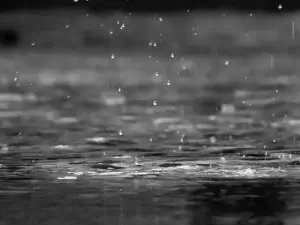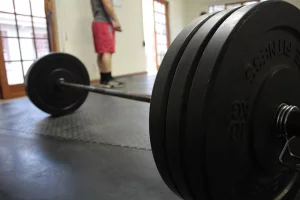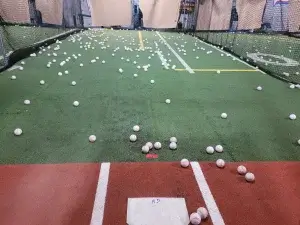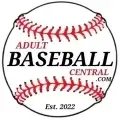Don’t let bad weather keep you from getting better at baseball
Baseball and bad weather don’t typically mix well. The ball, gloves and wood bats are expensive and can be ruined by excessive moisture. It’s difficult to keep hold of a bat and have a sure grip on a ball when they get wet. That can make for dangerous conditions for players.

It can be defeating when it’s cold, rainy or snowy outside. Getting out on the field isn’t an option. That can really put a dent in your baseball activities. It limits what you can do to improve your game.
But it doesn’t have to stop you from planning or training. If you make the right approach, you can come out as a better player when the storm clouds clear out.
bad weather baseball activities
In many parts of the baseball world, bad weather is a normal part of life. Summer rain and winter snow storms come like clockwork. In other parts, like coastal California, bad weather is just when that wet stuff randomly appears from the sky in the winter time.
No matter where you live, it’s a good idea to have a plan when playing outdoors isn’t an option.
use your time creating a long term practice plan
When you are stuck indoors, you can put your downtime to good use. Sometimes it can be productive to step back and take a look at what you do right and what you don’t.
evaluate
You’ve put countless hours into practice in your lifetime. But one of the things that can get overlooked when it comes to baseball training is reevaluating yourself and your practice plan. Taking the time to examine your skills is taking ownership of your play. We can tend to get into bad habits over time. If we don’t take a moment to recognize them, those habits become ingrained and hard to change.
When you can’t go outside, sit down and think about what you could be doing better on the field. Maybe you’ve been having trouble collecting groundballs or your throws have been going anywhere but where you want. Perhaps your arm strength isn’t what it used to be or your swing has been getting progressively worse.
We often tend to better recognize faults when we are detached from the emotion of games and practice.
Make a physical list of skills you would like to improve. Be specific, like wanting to get better at footwork on double plays. Or hit the ball the other way more often.
Don’t neglect the basics either. Think about your hitting and throwing mechanics. Is there anything there that should be better? Be honest with yourself.
research
Once you have a list of the parts of your game you want to work on, it’s time to start researching. A lot of us have big egos or an independent streak that prevents us from looking outward for help. Working with a coach is worthwhile, but conditions like cost and time might mean hiring a coach isn’t an option.
Thankfully, there are many resources online that can give you worthwhile ideas. Youtube is a great resource of tips for training or mechanical insights. Channels like You Go Pro Baseball, Ultimate Baseball Training or Coach Dan Blewett have a lot of content for you to study and compare. Some of the tips or drills are basic. But others might reveal a hole in your game or give you an epiphany into something you hadn’t thought of before.

Seeing how others go about doing what you want to accomplish is the first step to learning. But then you need to organize those approaches into one that works for you. Sometimes one coach or player has a completely different philosophy on hitting. So getting a lot of different opinions can help you determine the commonalities between them. There are some outliers, coaches teaching their own controversial tricks that you should be wary of. But with most coaching philosophies, it’s simply different paths to creating the same mechanics.
make your plan
Once you’ve figured out what you need to work on in your game, and researched the best ways to improve them, it’s time to organize a plan.
Most people will benefit from actually writing out a practice plan. Whether it’s with pen and paper, or typing it up on your phone or computer. Putting your plan into writing lets you visualize what you need to do moving forward. You’ll have something to look at to keep yourself on track, and it’s a way to stay accountable.
We live busy lives. The more you can plan out your training the more efficiently you can use your time in the offseason and on the field, once the sun comes out.
hit the gym
In reality, this should be part of your overall baseball training year round. Strength training helps your overall health and conditioning. For baseball, it builds up your muscular framework to be able to perform better in hitting, throwing and movement.
You can only swing a bat or throw a ball as fast as your muscles will allow.
 That’s not to say all weight training is equal. Exercises using low weight and high reps are good for rehabbing an injury or conditioning. It’s also great for certain fine motor muscle complexes that should not be utilizing heavy weight regularly (ie. rotator cuff).
That’s not to say all weight training is equal. Exercises using low weight and high reps are good for rehabbing an injury or conditioning. It’s also great for certain fine motor muscle complexes that should not be utilizing heavy weight regularly (ie. rotator cuff).
At the same time, most of your baseball movements will benefit from heavy lifting, with low to moderate rep counts. Baseball is an explosive sport and that type of movement requires the utility of Type II muscle fibers. Those fibers are developed when put under heavy stresses, like during heavy or high intensity exercises.
It’s normal to have an in season and off season routine.
During the playing season, lifting will usually be geared toward conditioning and maintaining strength. You can still lift to build during the season, but you run the risk of being too fatigued on game day if you are pushing yourself the same way you do In the offseason. While hitting the field for practice and games, you want to be in peak playing condition.
In the offseason though, It’s good to push for new levels of strength. Emphasize core lifts like squats, cleans and bench press that maximize your recruitment of muscle. Include baseball specific accessory lifts that will target leg and torso explosiveness. Add lifts that strengthen antagonist muscles, such as the back of the shoulder and biceps. Those muscles are important to help prevent injuries when throwing hard.
Additionally, rotational torso exercises should be part of every ball players routine. We use intense rotational movement in almost everything we do on the baseball field.
Work on becoming a better overall athlete and give extra time to areas where you need the most improvement.
When there’s bad weather outside, take your training to the gym. If you don’t have access to a gym, work out at home. Body weight exercises can be effective if you make sure you are pushing yourself and keeping the intensity high.
Take practice indoors in bad weather
 Depending on where you live, there may be some good options to take your baseball training inside. Opportunities may be limited in rural areas or places where there isn’t much bad weather to contend with. But in larger cities or places that are used to rain and snow, there are facilities made for indoor practice.
Depending on where you live, there may be some good options to take your baseball training inside. Opportunities may be limited in rural areas or places where there isn’t much bad weather to contend with. But in larger cities or places that are used to rain and snow, there are facilities made for indoor practice.
Batting cages are a great option to get in some hitting or short throwing. Gyms can be used for practicing groundballs, long toss and baserunning.
In the batting cage, work on the parts of your swing you want to improve. Let the ball travel and hit it the other way. Work on getting around to balls on the hands. Perfect contacting the barrel.
The game happens so fast that it takes 1000s of reps to develop the muscle memory to react instantly to a pitch or a play. Doing drills and training in a controlled environment during the offseason let’s you get in the reps you need to be ready for the season.
Even if you don’t have access to a large facility or local indoor batting cages, you can get some work in from the comforts of your living room. You can work on footwork for groundballs or throwing , balance drills for pitching or break down the movement patterns of your swing.
Practice the little things to dial them in for later.
Plan out your coming playing opportunities
You don’t train just for the sake of training. You put that work in to prepare to get out on the field. Games are where you get to see the results of work you’ve put in.
You may already have a team and league you play on. If not, though, now is a great time to find a league to play in or search for adult baseball tournaments in the coming year.
The more you prepare ahead, the more time you can commit to getting ready to ball out on the field.
Bad weather shouldn’t stop you from working on your game
Even when the weather isn’t cooperating, there are still ways to get in some baseball prep. You might need to get creative to get the most out of limited options. It may take some initiative on your part and some motivation, but you can take control of your game, even when you are stuck inside.
It’s up to you to make it happen. Don’t let bad weather be a hinderance to your training.
“Baseball is the pursuit of unattainable perfection.
